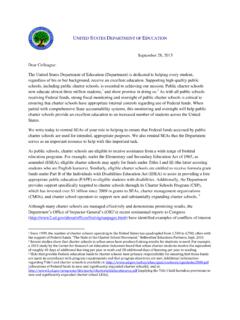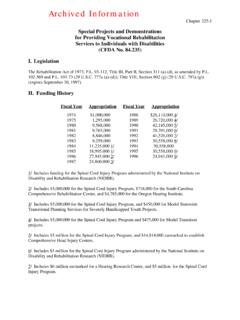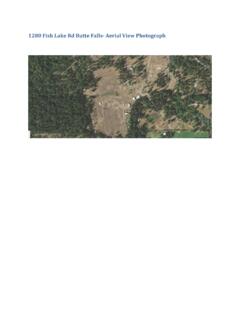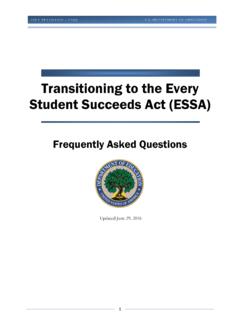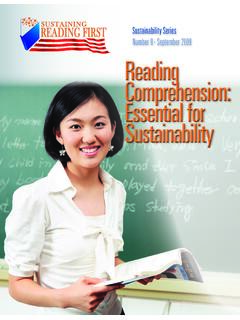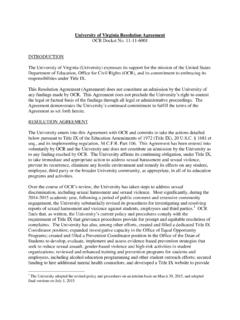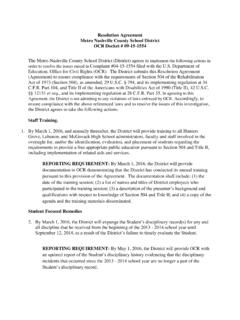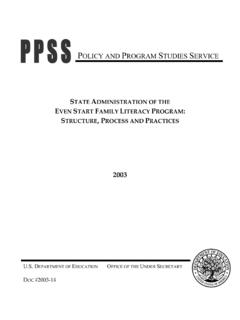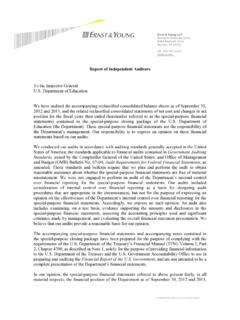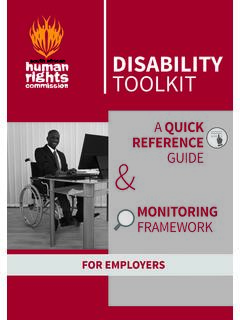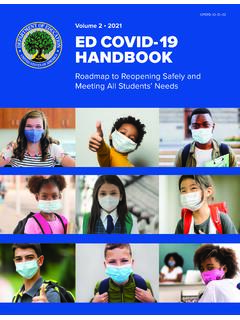Transcription of A TRANSITION GUIDE - ed
1 A TRANSITION GUIDE TO POSTSECONDARY EDUCATION AND EMPLOYMENT FOR STUDENTS AND YOUTH WITH DISABILITIES OFFICE OF SPECIAL EDUCATION AND REH ABILITATIVE SERVI CES UNITED STATES DEPARTMENT OF EDUCATI ON REVISED MAY 2017 Department of Education Betsy DeVos Secretary Office of Special Education and Rehabilitative Services Ruth Ryder Delegated the duties of the Assistant Secretary for Special Education and Rehabilitative Services May 2017 Initially issued January 2017 This report is in the public domain. Authorization to reproduce it in whole or in part is granted. While permission to reprint this publication is not necessary, the citation should be: Department of Education (Department), Office of Special Education and Rehabilitative Services, A TRANSITION GUIDE to Postsecondary Education and Employment for Students and Youth with Disabilities, Washington, , 2017. To obtain copies of this report: Visit: On request, this publication is available in alternate formats, such as Braille, large print, or computer diskette.
2 For more information, please contact the Department s Alternate Format Center at 202-260-0852 or 202-260-0818. All examples were prepared by American Institutes for Research under contract to the Department s Office of Special Education and Rehabilitative Services (OSERS) with information provided by grantees and others. The examples provided in this GUIDE do not necessarily reflect the views or policies of the Department. The Department has not independently verified the content of these examples and does not guarantee accuracy or completeness. Not all of the activities described in the examples are necessarily funded under Parts B or D of the Individuals with Disabilities Education Act (IDEA) or the Rehabilitation Act of 1973 (Rehabilitation Act), as amended by Title IV of the Workforce Innovation and Opportunity Act (WIOA). The inclusion of the information in these examples is not intended to reflect a determination by the Department that the practices are effective or that any activity, product, program, intervention, model, or service mentioned may be supported with IDEA or Rehabilitation Act funds.
3 The inclusion of these examples is for informational purposes only and should not be construed as an endorsement of any views, organization, product, or program by the Department or the Government. With respect to references to the Rehabilitation Act, this GUIDE addresses provisions authorized under Titles I, V, and VI of the Rehabilitation Act. The references to the Rehabilitation Act in this GUIDE , including the examples, refer primarily to Title I of the Rehabilitation Act. This GUIDE also makes reference to Section 504, which is part of Title V of the Rehabilitation Act and which addresses nondiscrimination rather than the authorization of programs administered by the State Vocational Rehabilitation agency. iii CONTENTS Preface iv 1. TRANSITION Planning: Opportunities and Programs to Prepare Students with Disabilities for Success 1 Overview 1 TRANSITION Planning 1 Education and Training Opportunities 2 Dual or Concurrent Enrollment Program 3 Early College High School 3 Summary of Performance 3 Employment Opportunities 4 Conclusion: Connections help achieve desired careers 7 2.
4 TRANSITION Services and Requirements: IDEA and the Rehabilitation Act 8 Overview 8 TRANSITION Services for Students under IDEA 8 TRANSITION Services for Students and Youth with Disabilities under the Rehabilitation Act 12 Distinctions between New Terms 13 Coordination and Collaboration between State Educational Agency (SEA) and VR Agency 16 Youth with Disabilities No Longer in School 18 Examples to Consider: States are Coordinating TRANSITION Services 20 Conclusion: Coordination is required 20 3. Options after Leaving Secondary School: Education and Employment Goals 23 Overview 23 Postsecondary Education and Training Options 23 Rights and Responsibilities in Postsecondary Education and Training 25 Postsecondary Employment Options 29 Types of Employment Outcomes Authorized under the Rehabilitation Act 30 Conclusion: Know Your Options to Plan 33 4. Supporting Student-Made Decisions: Preparation for Adult Life 34 Overview 34 Setting High Expectations for Secondary School Students with Disabilities 34 Person-Centered Planning 35 Addressing Students Social and Emotional Needs 35 Providing the Student and Youth with Support to Make Their Decisions 36 Making Informed Choices 37 Conclusion: Student Empowerment Advances Career Decision-Making 38 Glossary of Terms 39 End Notes 52 iv PR E FAC E The Office of Special E ducation and Rehabilitative Servi ces (OSERS), of the Department of Education (Department), is p leased to publish, A TRANSITION GUIDE to Postsecondary Education and Employment for St udents and Youth with Disabilities.
5 OSERS mission is to improve early c hi ldhood, educational, and employment outcomes and raise expectations f or all individuals with disabilities, their families, their communities, and the nation. To assist students and yout h with disabilities to achi eve their post-school and career goals, Congress enacted two key statutes that address the provision of TRANSITION servi ces: the Individuals with Disabilities Education Act (IDEA) and the Rehabilitation Act of 1973 (Rehabilitation Act), as a mended by Title IV of t he Workf orce Innovation and Opportu nity Act (WIOA). The IDEA is administered by the Office of Special Education Programs (OSEP), and Titles I, III, and VI, section 509, and chapter 2 of Title VII of the Rehabilitation Act are administered by the Rehabilitation Services Administration (RSA). OSEP and RSA, b oth components of OSERS, provi de oversight and guidance regarding the administration and provision of TRANSITION servi ces by State educational agencies (SEAs), local educational agencies (LEAs), and State Vocational Rehabilitation (VR) agencies.
6 Both the IDEA and the Rehabilita tion Act make clear that TRANSITION servi ces requi re a coordinated set of activities for a student with a disability within an outcome-oriented process. This process promotes movement from school to post-school a ctivi ties, such as postsecondary education, and includes vocational training, and competitive integrated employment. A ctive student invol vement, family engagement, and cooperative implementation of TRANSITION activities, as well as c oordinat ion and collaboration between the VR agency, the SEA, and the LEAs are essential to the creation of a process that re sults in no undue delay or d isruption in servi ce delivery. The student s TRANSITION fr om school to post-school a ctivities is a shared responsibility. OSERS presents this TRANSITION GUIDE to advance our ef for ts in ensuring that all students and youth with disabilities are equipped with the skills a nd knowledge to be engaged in the 21st Century workforce.
7 In doing so, OSERS recogni zes the signific ance of c ollaborative partner ships and hopes that the infor mation in this GUIDE will assist families and their students and youth with d isabilities in developing and pursuing their goals for adult life. This TRANSITION GUIDE addresses the f ol lo wing topics to facilitate a seamless TRANSITION fr om school to post-school a ctivi ties: TRANSITION planning: opportunities and programs; Tr ansition servi ces and requi rement s, as a uthorized by IDEA and the Rehabilitation Act; Education and employment options for s tudents and youth with disabilities after leaving secondary school; and Suppor ting decisions made by students and youth with disabilities. This GUIDE also includes real life ex amples, a sample flow chart of the TRANSITION process, and a glossary of key terms used in the TRANSITION process. A TRANSITION GUIDE TO POSTSECONDARY EDUCATION AND EMPLOYMENT FOR STUDENTS AND YOUTH WITH DISABILITIES v As students and youth with d isabilities prepare to TRANSITION to adult life, we must do everything we can to provi de them with the infor mation, servi ces, and suppor ts they need to ensure that they have the oppor tunity to achieve their g oals.
8 We hope this TRANSITION GUIDE will also help students and yout h with disabilities and their families to better understand how the SEA, the LEA, and the VR agency work toget her to facilitate improved outcomes for s tudents and youth with disabilities. If you have questions about this TRANSITION resource GUIDE , pl ease submit them to Sincerely, Ruth E. Ryder Delegated the duties of the Assistant Secretary for Special Education and Rehabilitative Services 1. TRANSITION PLANNING: OPPORTUNITIES AND PROGRAMS TO PREPARE STUDENTS WITH DISABILITIES FOR SUCCESS Overview As a student approaches the time to leave high school, it is important that preparations for adult life are well underway. For early TRANSITION planning and active participation in decision making to occur for students with disabilities, members of the planning team need to be well-informed about the student s abilities, needs, and available services. This section highlights educational opportunities, credentials, and employment strategies designed to assist students with disabilities while in school to prepare for a meaningful postsecondary education and thriving career.
9 TRANSITION Planning A truly successful TRANSITION process is the result of comprehensive team planning that is driven by the dreams, desires and abilities of youth. A TRANSITION plan provides the basic structure for preparing an individual to live, work and play in the community, as fully and independently as possible. 1 Local educational agencies (LEAs) and State Vocational Rehabilitation (VR) agencies participate in planning meetings to assist students and family members to make critical decisions about this stage of the student s life and his or her future post-school goals. During the planning process, schools and VR agencies work together to identify the TRANSITION needs of students with disabilities, such as the need for assistive or rehabilitation technology , orientation and mobility services or travel training, and career exploration through vocational assessments or work experience opportunities. The individualized education program (IEP), developed under the Individuals with Disabilities Education Act (IDEA), for each student with a disability must address TRANSITION services requirements beginning not later than the first IEP to be in effect when the child turns 16, or younger if determined appropriate by the I E P Te a m, and must be updated annually thereafter.
10 The IEP must include: (1) appropriate measurable postsecondary goals based upon age-appropriate TRANSITION assessments related to training, education, employment, and, where appropriate, independent living skills; and (2) the TRANSITION services (including courses of study) needed to assist the student with a disability in reaching those goals). While the IDEA statute and regulations refer to courses of study, they are but one example of appropriate TRANSITION services. Examples of independent living skills to consider when developing postsecondary goals include self-advocacy, management of the home and personal finances, and the use of public information. A TRANSITION GUIDE TO POSTSECONDARY EDUCATION AND EMPLOYMENT FOR STUDENTS AND YOUTH WITH DISABILITIES 2 Education and Training Opportunities There are a number of opportunities and programs available for students preparing to exit secondary school. Many of these education and training opportunities involve formal or informal connections between educational, VR, employment, training, social services, and health services agencies.
